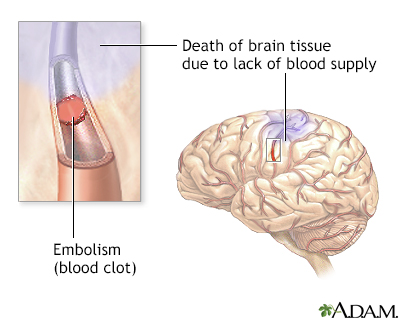Stroke

What is a Stroke?
A stroke is a serious medical condition that occurs when the blood supply to part of the brain is interrupted or reduced, preventing brain tissue from getting the oxygen and nutrients it needs. The cells in the brain begin to die in minutes.
Who's at Risk for a Stroke?
Risk factors for stroke include being overweight, being physically inactive, heavy or binge drinking, use of illicit drugs, cigarette smoking, high blood pressure, high cholesterol, diabetes, obstructive sleep apnea, cardiovascular disease, and personal or family history of stroke or heart attack. Older people and those of African or Asian descent are also at higher risk. Certain conditions like sickle cell disease can increase stroke risk, as can being pregnant, especially during the last months and the immediate period after delivery.
What Causes a Stroke?
There are two main types of strokes: ischemic and hemorrhagic. Ischemic stroke, the most common type, is caused by a blockage in an artery that supplies blood to the brain. Hemorrhagic stroke is caused by a blood vessel in the brain bursting or leaking.
How does a Stroke Start?
A stroke typically starts suddenly. In an ischemic stroke, a blood clot blocks a blood vessel in the brain. In a hemorrhagic stroke, a weakened blood vessel ruptures and bleeds into the surrounding brain tissue.
What are the Symptoms of a Stroke?
Stroke symptoms can be remembered with the acronym FAST: Face drooping, Arm weakness, Speech difficulty, and Time to call emergency services. Other symptoms can include confusion, trouble seeing in one or both eyes, trouble walking, dizziness, loss of balance, or a sudden severe headache.
How is a Stroke Diagnosed?
A stroke is usually diagnosed based on symptoms, medical history, physical examination, and diagnostic tests. These tests can include a CT scan or MRI to view the brain, blood tests, and other tests to check the heart and blood vessels.
How can a Stroke be Treated?
Immediate treatment is crucial for a stroke. For an ischemic stroke, treatment focuses on restoring blood flow to the brain, often using clot-busting drugs or procedures to remove the clot. For a hemorrhagic stroke, treatment usually involves controlling bleeding and reducing pressure in the brain, sometimes through surgery.
What Complications may Occur with a Stroke?
Stroke can lead to long-term complications, including paralysis or loss of muscle movement, difficulty talking or swallowing, memory loss or difficulties with understanding, emotional problems, pain, and changes in behavior and self-care ability.
How can I Prevent a Stroke?
Preventing a stroke involves managing risk factors: controlling blood pressure, quitting tobacco, managing diabetes, eating a diet rich in fruits and vegetables, maintaining a healthy weight, exercising regularly, limiting alcohol, and managing sleep apnea.
Long-term Management of a Stroke
Long-term management of a stroke may involve rehabilitation to help regain lost skills and adapt to any physical limitations. It can also involve medications or lifestyle changes to prevent future strokes.
What is Recent Research Saying About Stroke?
Recent research into strokes includes work on new treatments to protect the brain during a stroke, the use of stem cells to aid recovery after a stroke, and the development of new diagnostic tools.
Where can I go for More Information on Stroke?
For more information on stroke, consider resources such as the American Stroke Association, the National Stroke Association, or the World Stroke Organization. Your healthcare provider can also offer advice and information.

